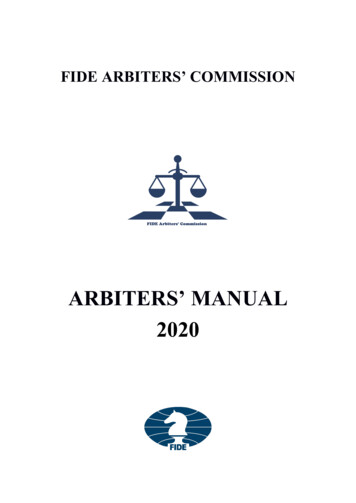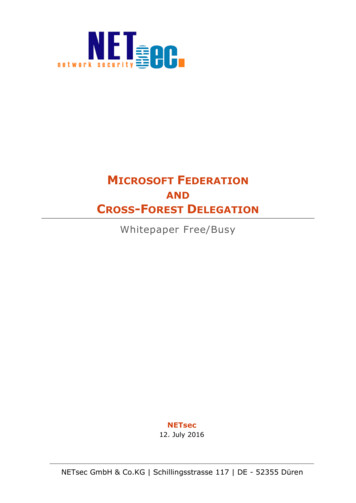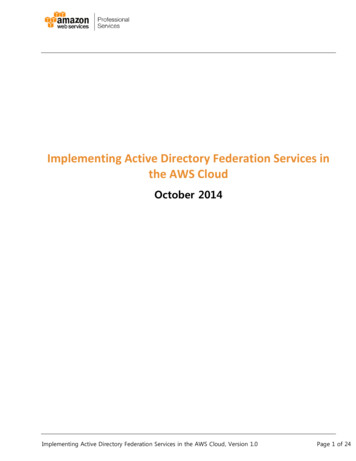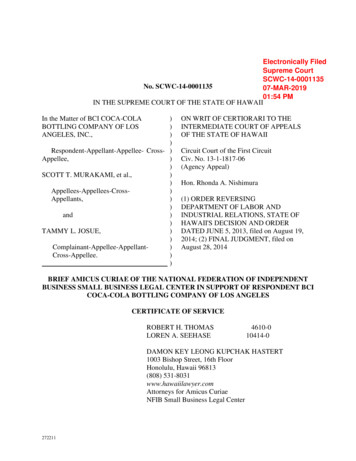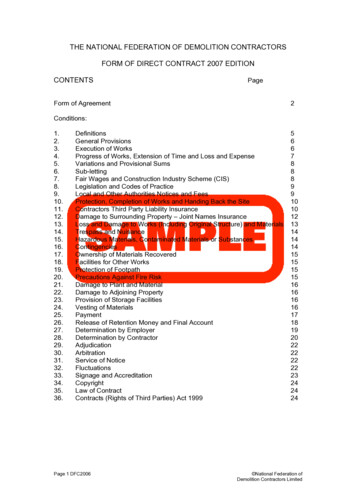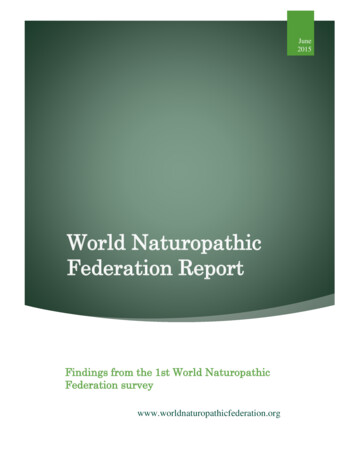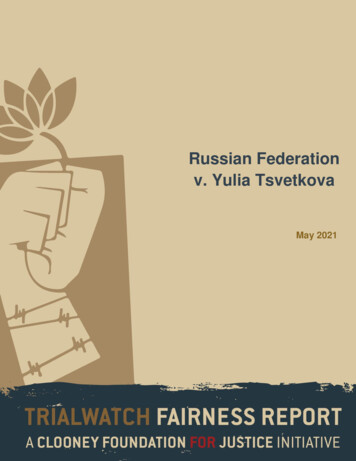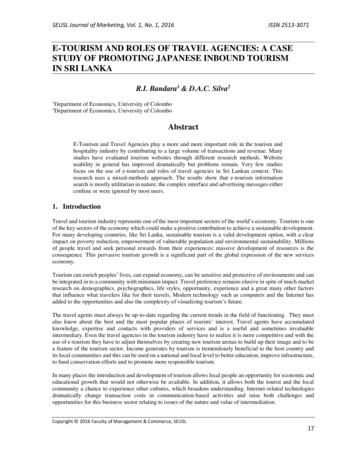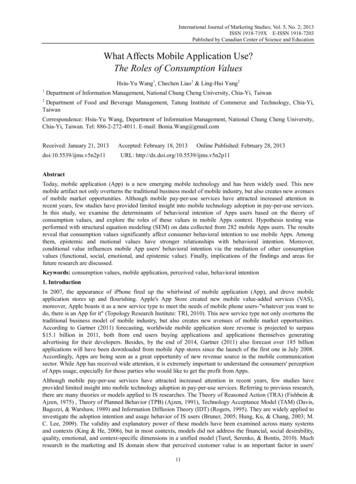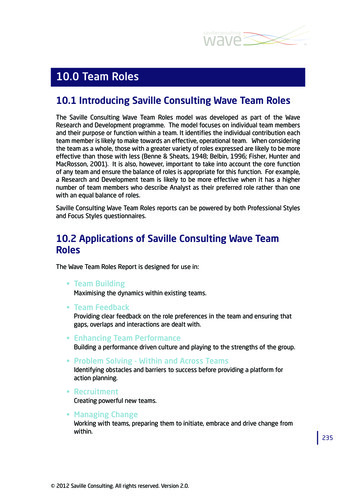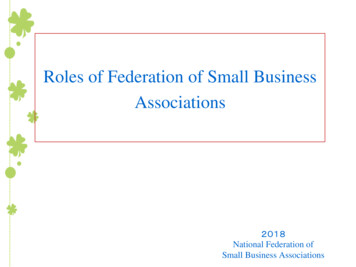
Transcription
Roles of Federation of Small BusinessAssociations2018National Federation ofSmall Business Associations
Three SMEs Organizations1. NFSBA(1) Member organization: 35 thousand associations, 3 million SMEs(2) 47 Prefectural Federations of Small Business AssociationsFund for activities (FY2010 Grants for supporting collaborations for 47 PrefecturalFederations of Small Business Associations: Total 6.4 billion yen)(3) Role: Providing guidance to associations, making policy recommendations, implementingpolicies, informing of actual conditions, etc.2. Japan Chamber of Commerce and IndustrySupport organization including those engaged in commerce and industry, etc. in “city” areas Urban areas, large enterprises and medium enterprises3. Central Federation of Societies of Commerce and IndustrySupport organization including those engaged in commerce and industry, etc. in “town” and“village” areas One Village, One Product campaign Advanced primary sector2
Outline of National Federation of Small BusinessAssociationsNational Federation of Small Business AssociationsPrefectural Federation of Small Business Associations (47)Business cooperative(20,053)Federation of business cooperative(372)Cooperative partnerships(510)Shopping district promotion(816)associationEnvironmental hygiene trade(131)AssociationOthers (including incorporated(3950)association)Small business cooperativeCredit cooperativeJoint business cooperativeCommercial associationFederation of shopping districtpromotion associationFederation of environmentalhygiene trade association(3)(104)(930)(915)(63)(4)27,851 organizations, etc.Nationwide cooperative association (124)Nationwide federation of cooperative(including fire mutual aid cooperative, creditcooperative, shopping district promotionassociation, environmental hygiene tradeassociation) (89)Nationwide commercial association and theirfederation (59)Nationwide commercial organization (otherIncorporated association, etc.) (101)373 organizations, etc.about 2.59 million companiesNational Federation of Small Business Associations3
Activities of Federation of Small Business Associations Providing guidance and support for all the business activitiesof SMEs, including the establishment of cooperatives,organization, operations, and management Broad support for business cooperatives, joint business cooperatives,cooperative partnerships, commercial associations, shopping districtpromotion associations, and LLP, LLC and new collaboration thatconsist of SMEs, and individual SMEs Providing education and information on cooperatives forSMEs Research and development of cooperatives for SMEs Proposals to the assembly and the administrative agency forthe development of SMEs and cooperativesNational Federation of Small Business Associations4
Characteristics of the System of Small and MediumEnterprise, etc. Cooperatives Establishment of the system of Small and Medium Enterprise, etc. Cooperatives Establishment of the Small and Medium Enterprise Agency . August 1948Enactment of Small and Medium-sized Enterprise Cooperatives Act . June 1949Small and medium enterprises, etc. cooperatives business cooperatives, credit cooperatives, federation ofcooperatives, joint business cooperativesEstablishment of National Federation of Small Business Associations . April 10, 1956 Characteristics of the system of Small and Medium Enterprise, etc. Cooperatives iSmall and medium enterprises that lack financial resources conduct joint businesses based on a spirit of mutualaid to raise their economic status.iiThere are a variety of cooperatives and associations, including credit cooperatives that are not allowed to conductother businesses than credit business.iii Introduction of the joint business cooperative system based on an entirely new conceptiv Expansion of membership eligibility due to widely ranging cooperatives(membership of credit cooperatives and joint business cooperatives)v Clarification of standards and principles of cooperatives and exception of the application of the AntimonopolyAct in principlevi Ensuring independence and democracy of cooperativesvii Emphasizing characteristics of cooperatives as a business entityviii Approving collective agreement in order to improve the economic status of cooperativesNational Federation of Small Business Associations5
Standards and Principles of Small and MediumEnterprise, etc. Cooperative[Standards](Article 5, paragraph 1 of Small and Medium-sized EnterpriseCooperatives Act)(1) Purpose of mutual-aid(2) Freedom of joining and withdrawing(3) Equal voting rights and rights to elect (one vote perperson)(4) Standard of dividends from surplus(dividend in accordance with the amount of use andrestraint of investing dividend)[Principles] (Article 5, paragraph 2, 3 of Small and Medium-sized EnterpriseCooperatives Act)(5) Direct and fair service(6) Politically neutralNational Federation of Small Business Associations6
Characteristics of (Small and Medium Enterprise, etc.)Cooperative(1) Business management:Generating profits and establishing a basis for economic independenceConducting necessary business for members based on members’ economy(self-responsibility of members and cooperatives)(2) Business entity:Conducting profitable businesses as an independent business entityInvesting capital to generate sustainable profits as a business entity(3) Actors are people (personality), not capital:Participation in management of an organization with one vote per personRestraint of investing dividend in principleProfits belong to members, not capital(dividend in accordance with the amount of use and restraint of investing dividend)(4) Organization with high ethicsConsequence of an organization of personalityNational Federation of Small Business Associations7
Characteristics of (Small and Medium Enterprise, etc.)Cooperative(1) Trinity organization:Ownership (investors) equals management (managers) and utilization(users)(2) Changing organization:Started to meet members’ needs and its organizational structure changes tomeet members’ needsJoint businesses also change to meet members’ needs(3) Self-help organization:Members generate their own profits through joint businesses(4) Mutual-aid organization:Mutual-aid is established as a system by members who use joint businessesin order to create the basis of their economic independence.National Federation of Small Business Associations8
Trinity Structure of Small and Medium EnterpriseCooperativeMembers as investors (general meeting)InvestmentInvestmentMembers as managers (Board of directors)Decision-making andexecution of businessUtilizationUtilizationMembers as users (customers)National Federation of Small Business Associations9
Types of Joint Businesses of Small and Medium EnterpriseCooperativeSupport operations forinfrastructureJoint operations (upstream)Support operations for collaborationand exchangesFinanceProcurement, purchasingProduction, nDebt guaranteesMutual aidShared use of facilitiesTransportation andStorage InformationserviceResearch and studiesStaff trainingWelfareOutsourcing etc.Cross-industrial exchangesMembers’ business (management)Current operationsJoint operations (downstream)Sales, acceptance of orderAdvertisement, market developmentNational Federation of Small Business AssociationsOperations in new fieldsSupport operations for development ofnew fieldsDevelopment of new technologies andnew products, development of a newmarket, and development of a newbusiness model10
Types of Joint Businesses of Small and Medium EnterpriseCooperative Support operations for infrastructureOperations for members’ general management regardless of types or contents oftheir businesses Joint operationsOperations for practical business conducted by membersUpstream: operations for procurement of raw materials and merchandiseDownstream: Operations for sales of products Support operations for the development of new fieldsSupport operations for members’ advancement to new fields, not for currentoperations Support operation for collaboration and exchangesOperations to provide opportunities to collaborate and exchange betweenmembers and outside institutions, or to become a liaison between the two fortheir collaboration and exchangesNational Federation of Small Business Associations国11
Types of Joint Businesses of Small and Medium EnterpriseCooperative (Business Cooperatives and Minor Business Cooperatives)Article 9-2 A business cooperative or a minor business cooperative may conduct allor part of the following activities:(i) Production, processing, sales, purchasing, storage, transport, inspection and otherjoint activities related to the business of partner(ii) Loan of business funds (including discounting of negotiable instruments) topartner and borrowing of such funds for partner(iii) Activities related to the welfare of partner(iv) Activities related to the education and offer of information for achieving animprovement of the management and technology concerning the business of partnerand the dissemination of knowledge concerning the cooperative's activities(v) Activities related to research and development with regard to new goods or newtechnology or the cultivation of a demand for facilitating partner to advance into newbusiness fields(vi) Conclusion of collective agreements for improving the economic status of partner(vii) Activities incidental to the activities set forth in the preceding itemsNational Federation of Small Business Associations12
Types of Joint Businesses of Small and Medium EnterpriseCooperative Mutual-aid and support and cooperation Risk-aversion organization and business model organization (risk-taking) Organization to adjust the economic and business environment and toprovide outsourced business resources Organization that allows the freedom of no use of joint businesses andthat does not allow the freedom of no use of joint businesses Business collaboration and business integrationNational Federation of Small Business Associations13
Structure of Business Operations of Small and MediumEnterprise CooperativeInfluence of environmentalchangesProducts and merchandize marketsInfluence of environmentalchangesMembers as investorsChanges in needsDecision-makingMembers as managersExecution of joint businesses(management)(Board of directors and Secretariat)Utilization of jointbusinessesMembers as users of businessesResponse to environmentalchangesResponse toenvironmental changesMarkets for the factors of productionChanges in business (management) environmentChanges in business (management) environmentNational Federation of Small Business Associations14
Three Participations in Small and Medium EnterpriseCooperativeThree participations in cooperativesGeneral meetingParticipation in decisionmakingMembersBoard of directorsCommitteeParticipation in decisionmakingChief ExecutiveOfficerParticipation in decisionmakingExecution of jointbusinessesNational Federation of Small Business AssociationsDecision-making ofbusiness policyby membersDecision-making ofbusiness strategy bymemberrepresentativesOverseeing ofbusiness operationsOpinions to Board ofDirectorsBusiness planningDirection of thesecretariat forbusiness operationsMembers’ use ofbusinesses15
SME Policy and Small and Medium EnterpriseCooperative(1) Organized as major propositions of SME policy (after World War Twoto early 1950s) At this time, the government intended to mainly guide SMEs to establish their ownindependent cooperatives and rationalize their management through their proactivejoint businesses.(2) Modernization and enhancement policy and diversified forms oforganization (late 1950s to early 1960s) SMEs created various forms of organizations such as industrial parks, wholesalecommercial parks, truck associations, joint plant associations, joint store associations,chain business associations. The enhancement policy of the structure of SMEspromoted the diversification of organizations, including business cooperatives.National Federation of Small Business Associations16
SME Policy and Small and Medium EnterpriseCooperative(3) Actor of developing a structural improvement policy and planning (late1960s to early 1970s) Cooperatives were required to play a role of developing “plans” starting with astructural improvement system. The role was played for structural improvementplans and other planning systems based on “SME Modernization Promotion Act” andvarious Acts.(4) Knowledge-intensive policy and qualitative changes of cooperatives(mid-1970s to 1980s) The policy changed the quality of businesses as “software” of cooperative businessesand created a form of organization called cross-sector cooperative (integratedcooperative). The integration was a role of organizing SMEs in the structuralimprovement (conversion) policy.National Federation of Small Business Associations17
SME Policy and Small and Medium EnterpriseCooperative(5) Structural reforms, business start-up policy and various forms oforganizations (1990s) With support of “organizing various forms of body” including the establishment ofcooperatives such as joint investing companies and voluntary groups, small andmedium enterprise cooperatives have been regarded as an option among variousforms of organizations.(6) Competition-promoting policy for SMEs and independence fromgovernmental policies (since 2000s) Small and medium enterprise cooperatives are one of various measures to promoteSME policy. They are not in a position to play a role as the basis of developingmeasures to promote SME policies. It is necessary for small and medium enterprisecooperatives to become independent from governmental policies.National Federation of Small Business Associations18
Outline of National Federation of Small Business Associations National Federation of Small Business Associations Prefectural Federation of Small Business Associations (47) 27,851 organizations, etc. 373 organizations, etc. about 2.59 million companies Nationwide cooperative association (124) Nationwide federation of cooperative (including fire mutual aid cooperative, credit cooperative .File Size: 253KBPage Count: 18
![[MS-ADFSOD]: Active Directory Federation Services (AD FS .](/img/1/5bms-adfsod-5d.jpg)
